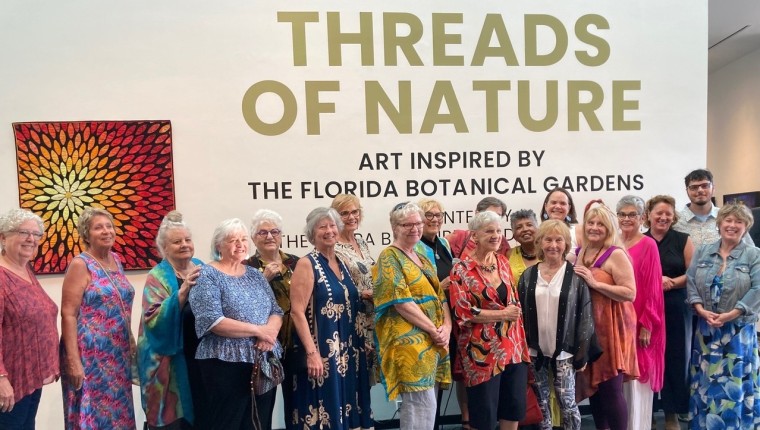and The Dalí
Threads of Nature
Through October 6
Free
Gallery at Creative Pinellas
Details here
Reimagining Nature
Through October 20
Dalí Museum
Details here
Everything’s coming up roses — and peonies, azaleas, daisies and all manner of garden stuff — in area museums this summer.
Two exhibits in particular take an unusual — and highly imaginative — approach to botanical art: Reimagining Nature: Dalí’s Floral Fantasies at the Dalí Museum in St. Pete and Threads of Nature: Art Inspired by the Florida Botanical Gardens at The Gallery at Creative Pinellas in Largo.

Reimagining Nature displays three rarely seen print series by Salvador Dalí, surreal fantasies inspired by 19th century botanical prints – on display together for the first time in two decades.
This is an exhibit for those who say they don’t care for Dalí’s work. Here is a very accessible Dalí, artist of the subconscious, the master of discovering invisible images – reworking very traditional, conservative prints, giving them both whimsy and the characteristic Dalinian edge.

Threads of Nature appeals even more to our sense of fun and awe in the face of nature. This show displays 68 pieces by fiber and multi-media artists of the Tampa Bay Surface Design Guild who were inspired by the flora and fronds of the Florida Botanical Gardens in Largo, the 100-acre park surrounding the gallery.
Trust me. You’ve never seen gardens like these.
Delightfully, these two tributes to nature and human creativity soon will be crossing paths. On September 4 at 10 a.m. Emily Goot, executive director of the Florida Botanical Gardens, and Beth Gelman, senior director of arts and cultural programming at Creative Pinellas will be the featured speakers at The Dalí’s monthly Coffee With a Curator talk.
If you can’t make it in person, stream it in real time or watch later on YouTube. You can also stream the August 7 talk in this series, a sold-out event featuring David Berry, chief museum curator at Sarasota’s Marie Selby Botanical Gardens.
And don’t miss June’s Coffee talk with Dalí curator Peter Tush who gave an amazing overview of the Dalí show.
But then be sure to treat yourself to both of these exhibits in person. They are they next best thing to actual forest bathing.

Walking through Threads of Nature is like discovering your own secret garden. Bright red “azaleas” pop out of Barbara Ellen Williams’s work, Azaleas in Bloom, a framed appliqué quilt.
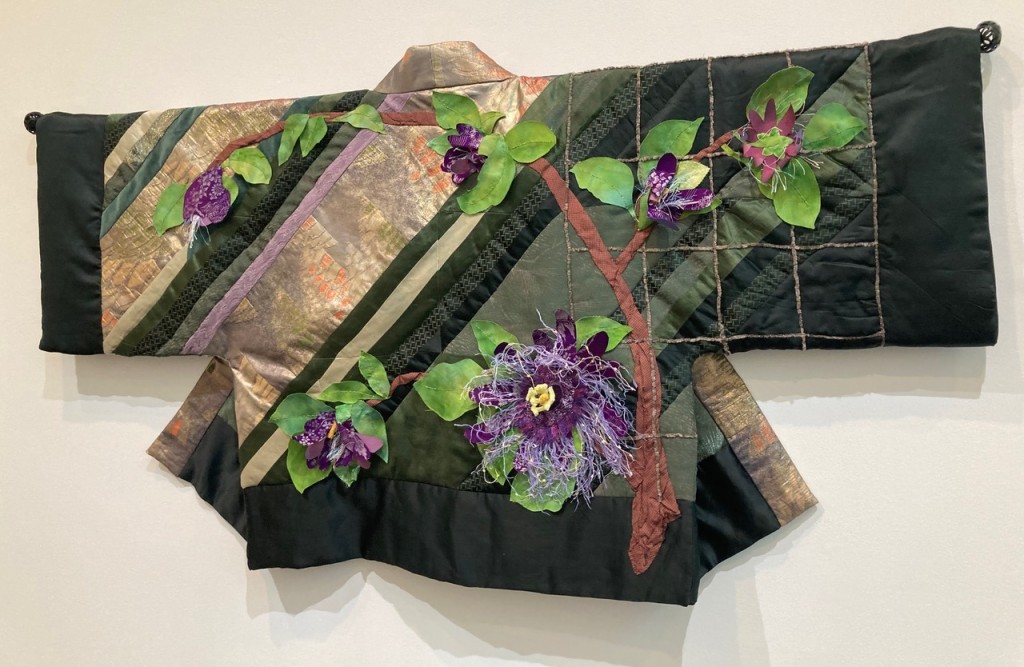
Wall hangings in the form of a kimono and a smock by June Colburn (Purple Passion Vine) and Elizabeth Neily (The Garden Dress) burst with exotic flowers in 3D. Bonnie Hacker created a collage made from quilted cotton fabric to conjure up Botanical Dreams. Kiki Alexander’s quilted scene, called Rain Song, literally drips blue rain drops.
For what’s a garden without rain?

A row of exquisite 8×8 framed theadpaintings by Susan Lumsden depict a caladium, a Mexican flame vine and a Brugmansia aka Angel’s Trumpet. They are flanked by an ethereal dragonfly and a ghostly butterfly, hand-stitched, hand-dyed works by Mei-Ling St. Leger.
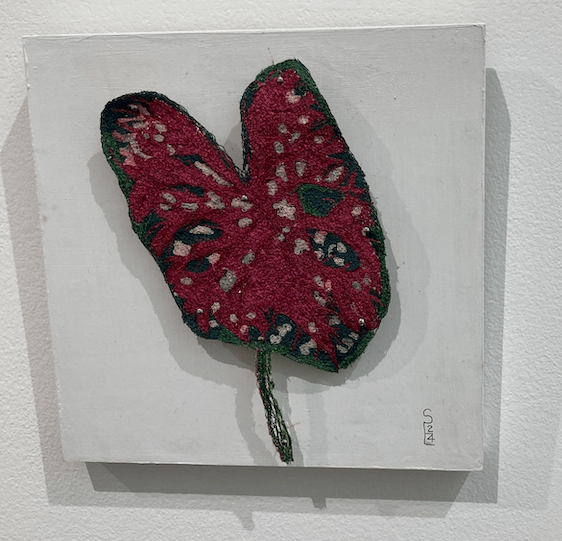

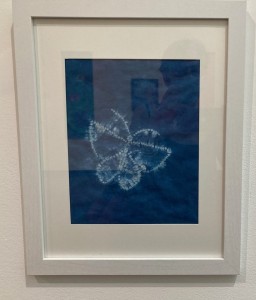
St. Leger made those hauntingly beautiful creatures using a traditional Japanese textile art called Shibori (from the Japanese word “shiboru, meaning wring, squeeze or press).
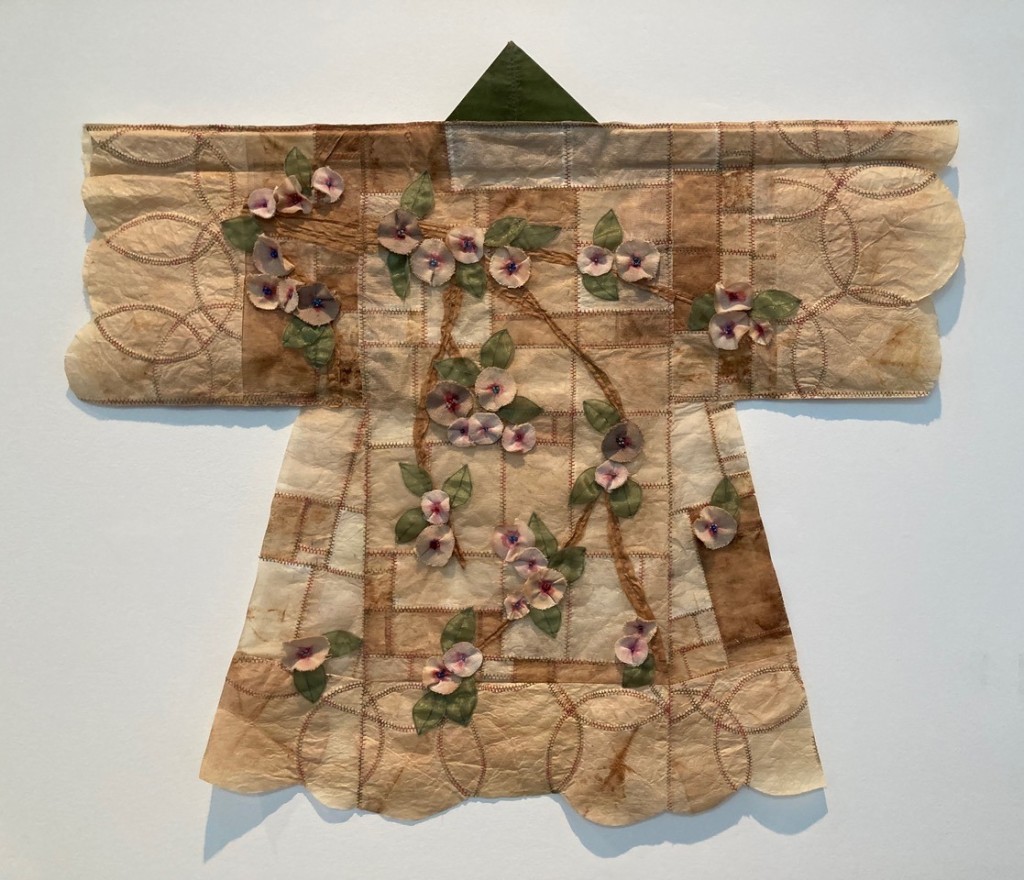
Unusual materials abound in this exhibit. Carol Hess’s “kimono” wall hanging is made from coffee filters and is decorated with “cherry blossoms” made from tea bags. It’s called Sakura, Japanese for cherry blossoms.
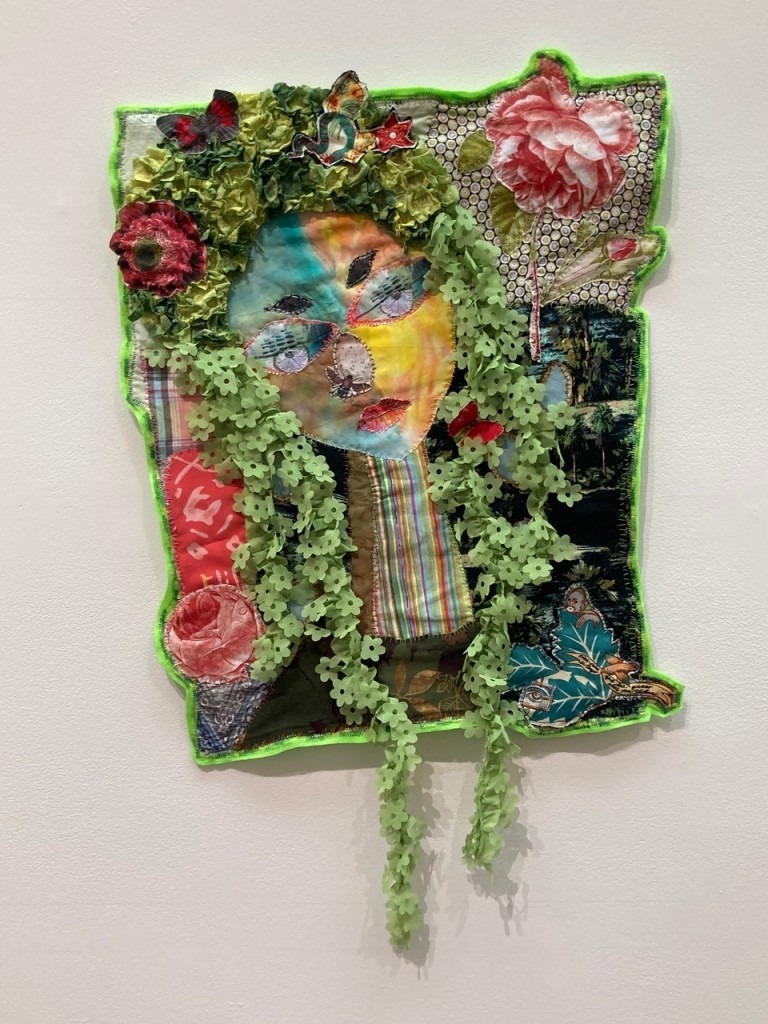
Kathleen Peel’s Phoenix Rising is an appliqué made from silk ties. Cynthia S Townley’s quilted portrait, Lilith, I Was Here First, has leafy tresses filled with butterflies and flowers made from recycled clothes.
There also are pieces in the show that mix fabric with other materials or don’t use fabric at all — not all of the members of the Surface Design Guild are fiber artists.

Kayrn Kozak’s Shadows Through the Woods is made with polymer clay over porcelain. Debra Campbell’s Fall Fantasy includes embellished silk but is a mixed media piece. Aida Sheets’s Fanciful Flowers & Fronds is a cardboard sculpture made with paper, paint and glue.


For Remembering Vincent Adorned, Katie Deits, inspired by Van Gogh’s sunflowers, started with a painting which was printed on fabric and then embroidered and embellished with glass beads.
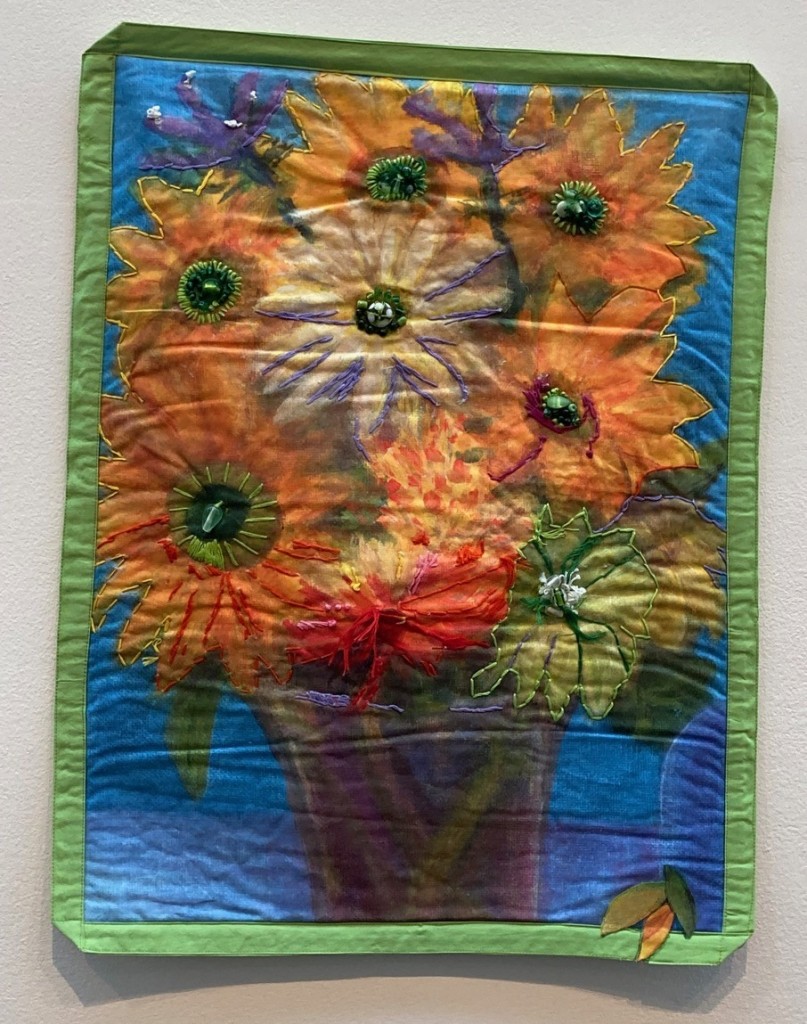
When you tour Threads of Nature, don’t forget to look up. You’ll see Leeann Kroetsch’s Butterflies in the Garden, cotton banners also made using the Shibori method, swaying above you, looking like, well, butterflies fluttering across the room.
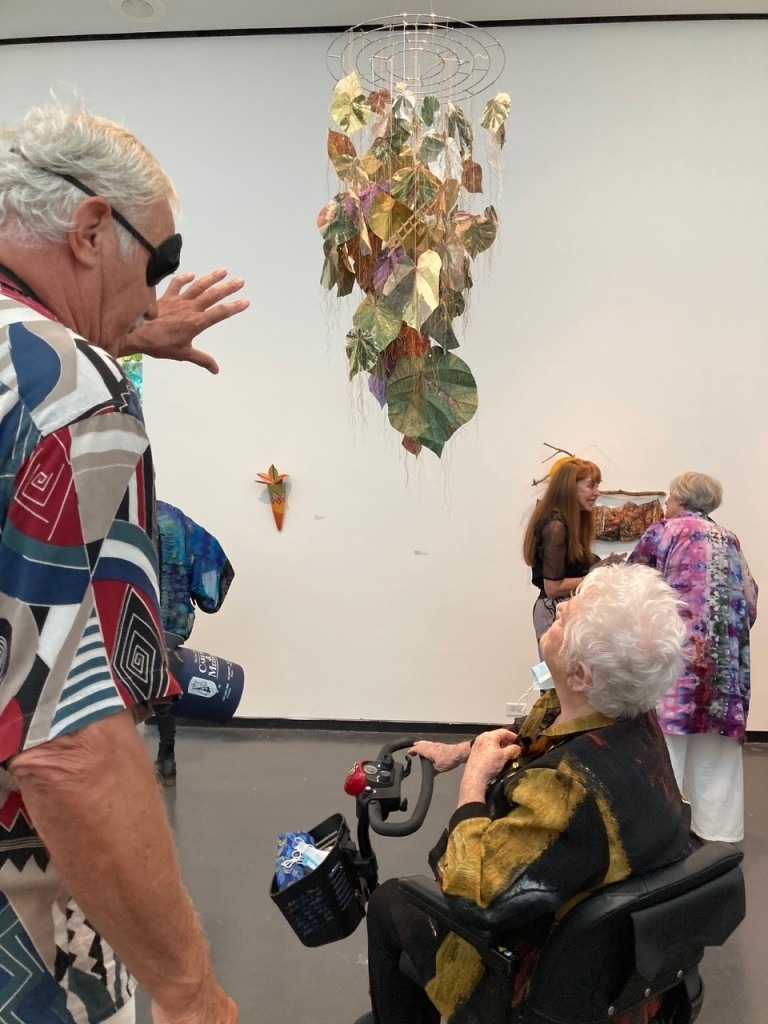
You’ll also see an intriguing mobile of multicolored leaves hanging from a circular frame with a tiny ladder embedded in the middle.
The creator of that mobile is Barbara Kazanis, a retired art educator (during her 28 years of teaching at USF, she founded and ran the Center for Arts and Community whose programs were aimed at bringing “art to other places” such as hospitals, prisons, schools and elderly homes).
At the July opening of Threads of Nature, I spotted her, seated in a motorized chair, explaining the piece to a man with a patch over his eye. Why a ladder? The name of the piece — Refuge — is linked to the word refugee, Kazanis is saying. Yes, I see – Ladders. Symbols of connection, symbols of climbing to new worlds.
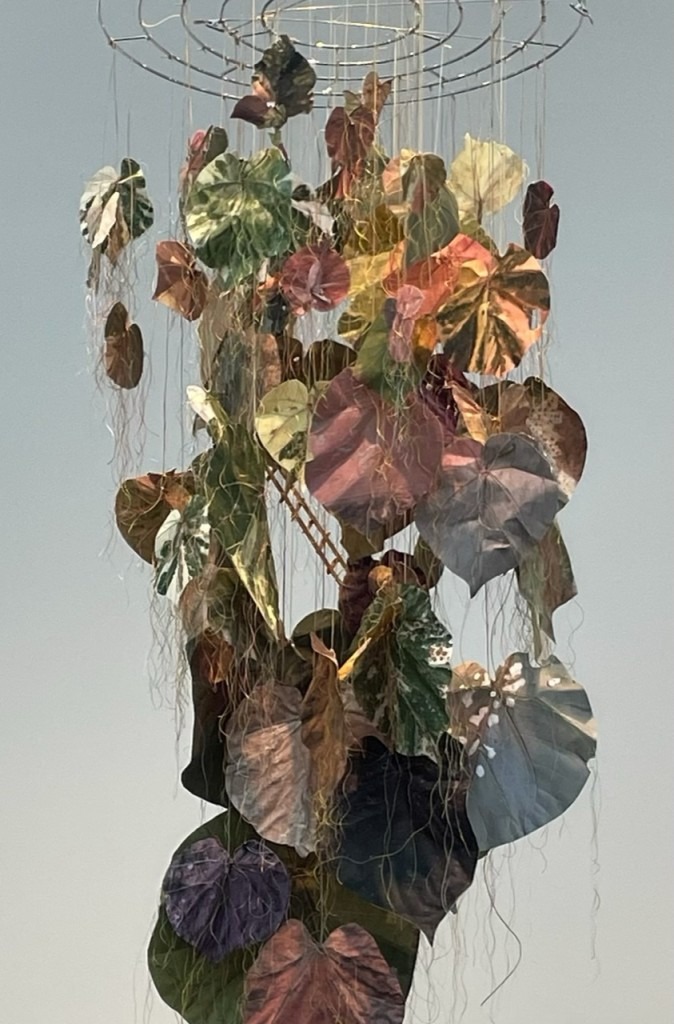
Working on the piece for a year, Kazanis made pictures, back and front, of actual leaves, then sewed the photographs together with wax thread. The large heart-shaped tricolored leaves — green and white with touches of red — came from the Mahoe tree, a semi-tropical plant belonging to the hibiscus family. Its blossoms create flowers in the summer that open yellow in the morning and turn red by sunset. There are several on the grounds of the Florida Botanical Garden.
Why all this interest in nature? I ask Kazanis.
“Nature is a living architect whose vision is calling us again. It is the only thing that gives us community,” she says. “We need to be with living things. By learning from nature to connect with living systems, we learn to connect to each other.”
Making the mobile was fun, she adds. “I like to work with the very expression of nature itself. How does it know to change its color and shape? Aren’t we also like that? We are nature.”

Not all the pieces in Threads of Nature evoke outdoor scenes. One of the most unique installations is a bedroom setting, created by Beth Gelman who is the curator of the show, that ties together several pieces.
A single bed (donated by Stageworks Theatre), is covered with Wonky Florida Bedspread, a cotton, hand-dyed and screen-printed piece by Sherry Dorst.
Dorst also contributed a basket-shaped lampshade, made from reeds and silk fiber “paper,” which Gelman hung, appropriately enough, over a sewing machine.
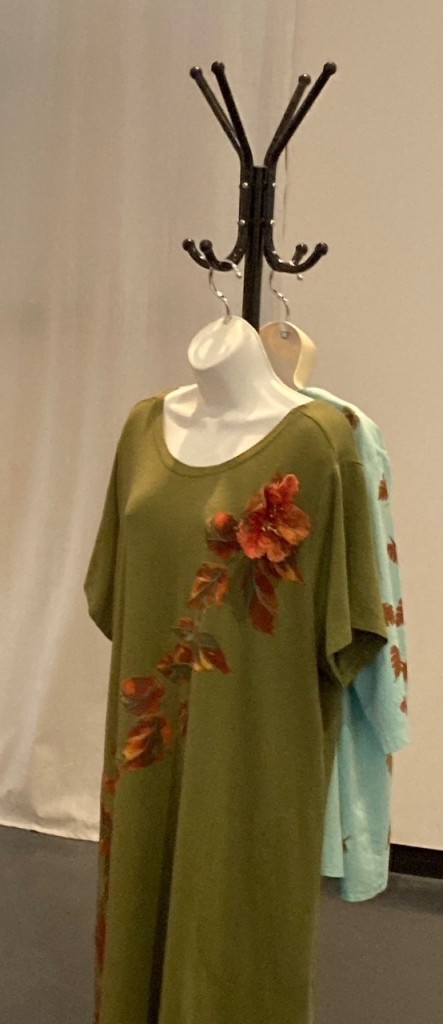
On one wall staged in front of a “window” there are gauzy drapes (Riot of Color), made by Elizabeth Niely with Shibori-dyed chiffon silk. A dress (Trailing Vines Casual Dress) and a shirt (Tropical Winds Cotton Top), works of art by Barbara Ellen Williams, hang nearby on a clothes tree.
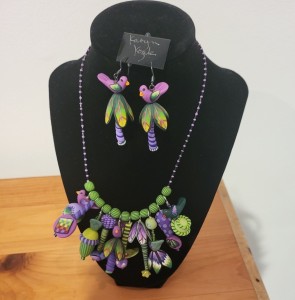
Along another wall of the “bedroom” is a dresser, topped by Dream Garden, a mixed media piece by Donna Isaac, that looks down on a display of jewelry – a necklace and earrings made by Kayrn Kozak with polymer clay and seed beads (Birds in the Trees), Cheryl Ann Day Swallow’s enamel jewelry set made with palm tree bark and Claude Barsa’s copper, brass and sterling silver bracelet (Leaves on the Wrist).

“While I created (the bedroom installation) to satisfy my own creative whimsy :-), I did want to subtly make the point that the work we hang on our gallery walls can be, as Oscar Wilde put it, ‘art we live with,’” Beth Gelman wrote to me in an email. “What we all choose to display on the walls — or the beds or dressers — of our own homes can transport us daily.”
Opening night of Threads of Nature drew more than 300 people, many sporting clothes with a nature theme. Refreshments were served, including a cake decorated with — of course — flowers.
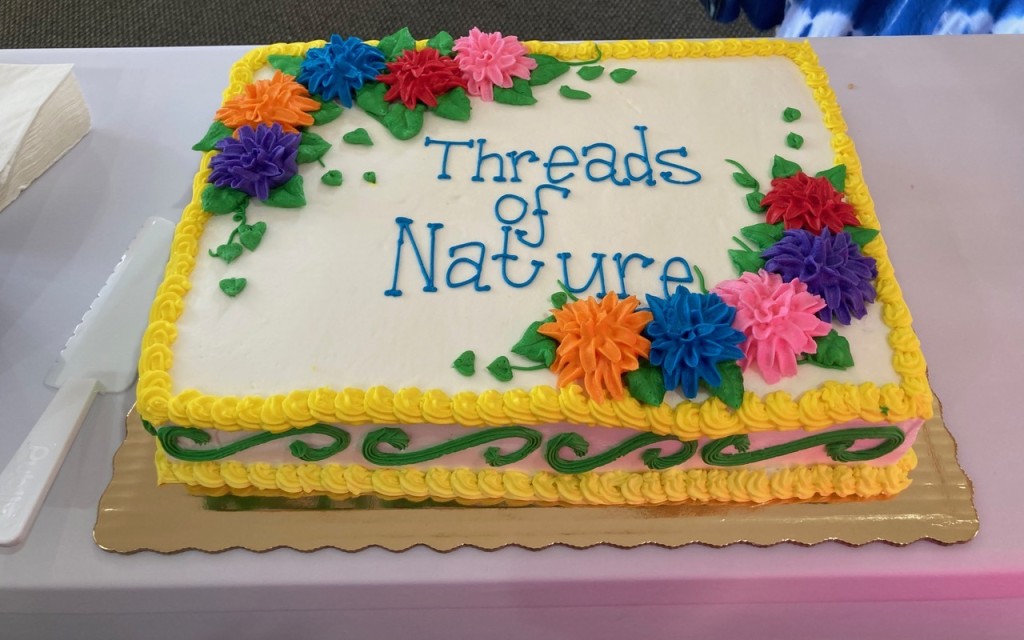
Throughout the evening, people took their time examining these works, often leaning in close to try to figure out just how these mesmerizing pieces were made.

Perhaps not surprisingly, I saw the same kind of close attention by museumgoers at the Reimagining Nature exhibit at the Dalí. Every print in that show is filled with so much detail that it’s hard to take just a cursory look at them.
Besides, many of the prints are just so fun to look at.
Who but Dalí would think to turn the Marguerita Daisy into Chrysanthemum frutescens with blossoms that are transformed into breakfast plates with two sunny side up eggs, one with a side of bacon?

Who but Dalí would notice that the blossoms of a lily look like the horns of a gramophone and that their pistons look like musical notes? Taking a conservative botanical print of a common lily, he renamed it Lilium Musicum (Dalí clearly had fun making up these Latin nomenclatures), jazzing it up as a musical tribute, complete with records, musical scores and a sketch of a classical pianist at its base.

To honor that very popular print, the Dalí offered two concerts to coincide with the exhibit. On June 27, students from Rebecca Penneys Piano Festival performed a sold-out show. On August 27 the museum will host a performance of the Fulton Chamber Players from 6-7 pm.
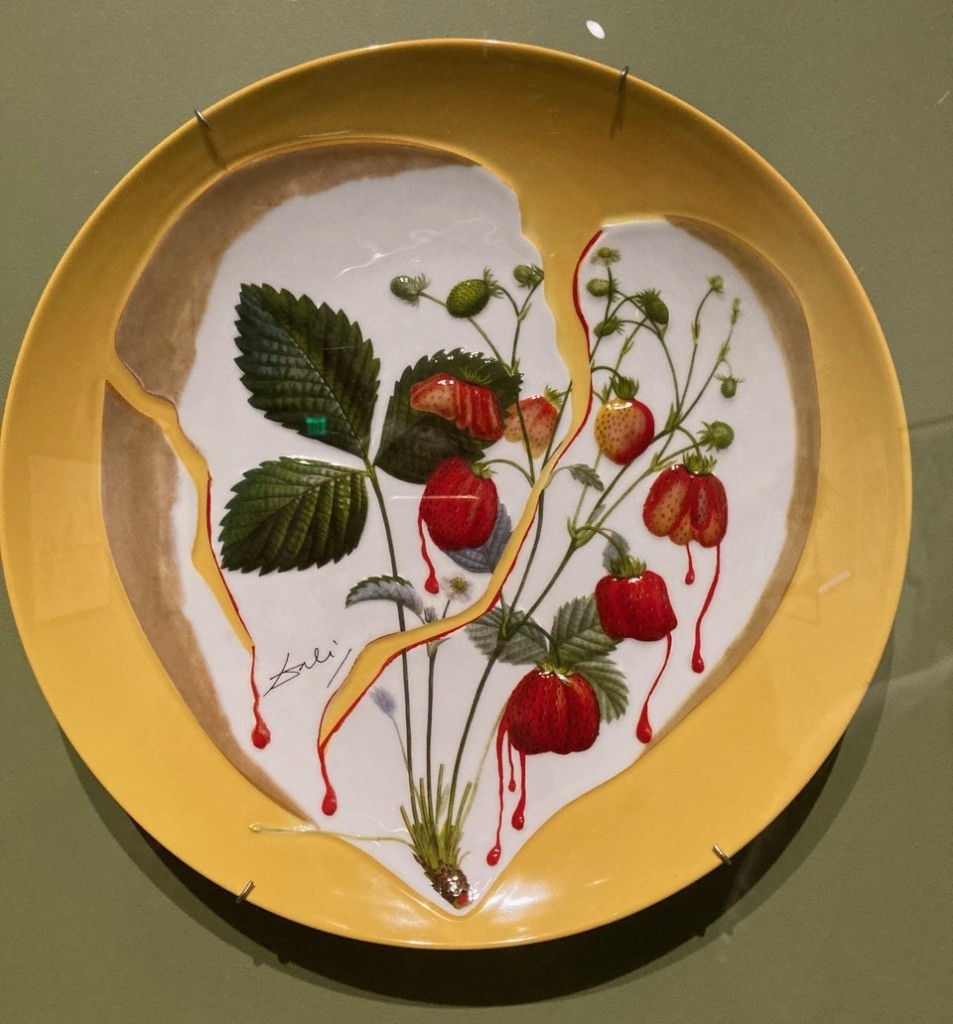
Dalí had a lifelong obsession with flowers, perhaps because in the arid climate of Catalonia where he was born, they were so rare. He often included a floral theme in his oil paintings. Included in the show is Three Young Surrealist Women Holding in Their Arms the Skins of an Orchestra, for example, in which the heads of the three figures are blossoming roses in various stages of decay.

Also on display are iconic photographs of Dalí posing with flowers at the end of his famous mustaches and Limoges plates printed with his transformed botanical images, and Dalí oil paintings with flowers in them.
The highlight, however, are the three fanciful suites of Dali’s prints – ten from his 1968 flower series (Flora Dalínae), 12 from his 1969 fruit series (FlorDalí) and 15 from his 1972 Florals (surrealist flowers) series.
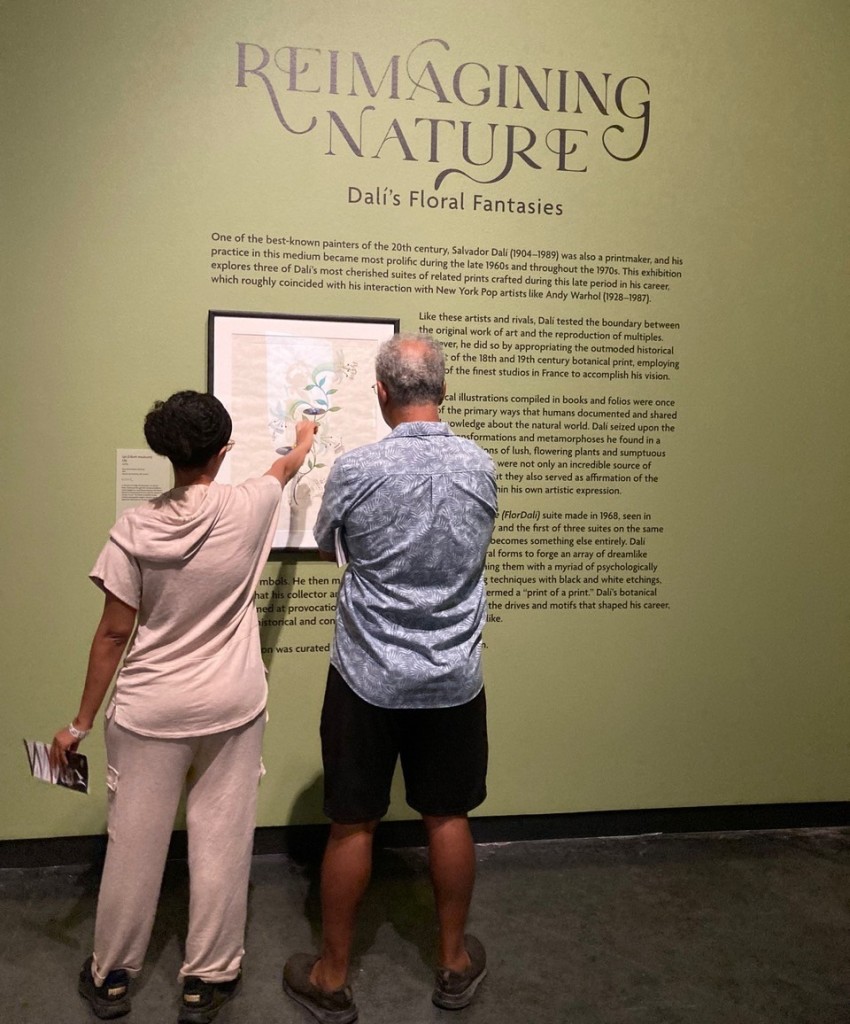
According to Peter Tush, the show’s curator, Reimagining Nature came about for an unusual reason. The Dalí Foundation has made it illegal to reproduce any of those Dalí prints as posters. The botanical prints, however, are among the most popular images in the museum’s collection.
So about a year and a half ago, the museum decided, unable to offer posters for sale to the public – that they would create a beautiful book based that could be sold in the museum’s gift shop. The exhibit emerged from that project.
“So the show came because of a catalogue, not the catalogue because of the show,” laughs Tush, adding, “Fun fact – you can use a razor blade and slice these images out…” Perhaps they won’t be as large as a poster would have been, but very beautiful nonetheless, he adds.
“The true painter must be able, with the most usual things to have the most unusual ideas,” Dalí once said.
“That is the idea of the entire show,” says Tush.
